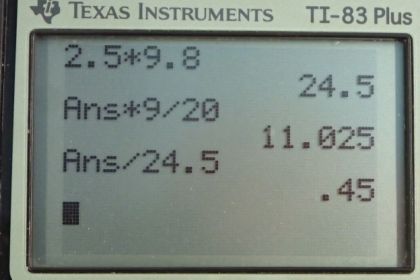Question
(a) What force must be exerted by the wind to support a 2.50-kg chicken in the position shown in Figure 9.32? (b) What is the ratio of this force to the chicken's weight? (c) Does this support the contention that the chicken has a relatively stable construction?
Final Answer
a)
b)
c) Yes, the chicken has a stable equilibrium. With the CM low and between the feet, if the CM is moved slightly towards a foot it will tend to return toward it's equilibrium position.
Solution video
OpenStax College Physics, Chapter 9, Problem 11 (Problems & Exercises)

vote with a rating of
votes with an average rating of
.
Calculator Screenshots
Video Transcript
This is College Physics Answers with Shaun Dychko. Let’s calculate the weight of this chicken, it’ll equal mg, so that’s 2.5 kilograms times 9.8 newtons per kilogram which is 24.5 newtons. That weight is assumed to be acting on this point here, the center of gravity. The level arm for the center of gravity is this line here but we’re going to take its perpendicular component which is this nine centimeters here. We’re going to write nine centimeters as 9.0 times ten to the minus two because the prefix centi means multiplied by ten to the minus two when we write it in meters. Which actually doesn’t matter becaus since we’re dividing these two length units here, what matters is that they have the same units. So we could have ignored the times ten to the minus two, both of them, and it would have given the same results, but if you convert one you have to convert the other. So the clockwise torque has to equal the counter-clockwise torque in order for this chicken to be in equilibrium and the wind is tending to make the center of gravity go clockwise and that torque will be the force of the wind which we’re going to find, multiplied by the perpendicular component of its level arm and that is going to be, well here is the, I supposed we imagine that the wind is acting on the center of gravity as well or it could be acting here, it doesn’t really matter because either way, well let’s say it’s acting here then, either way the perpendicular component of the level arm will be this length here which is 20 centimeters. So we have force of the wind multiplied by its perpendicular component of its level arm equals the torque due to gravity which is tending to go in the counter-clockwise direction, force of gravity multiplied by its level arm, and we’ll divide both sides by the level arm of the wind perpendicular and we end up with this line here. So the force exerted by the wind is 24 and a half newtons times nine centimeters divided by 20 centimeters and this gives 11.0 newtons. The ratio of the force of the wind to that of gravity is 0.45 when you divide the two, and yes the chicken has a stable equilibrium because the center of mass is relatively low and it is between the feet, and so if the chicken is pushed over a little bit and so the center of gravity moves a bit to one side or the other, the torque due to the gravity will tend to make the chicken return to its original position, provided that the wind isn’t too strong. So if something is perturbed from equilibrium and it returns back to its equilibrium position, that is known as stable equilibrium.

